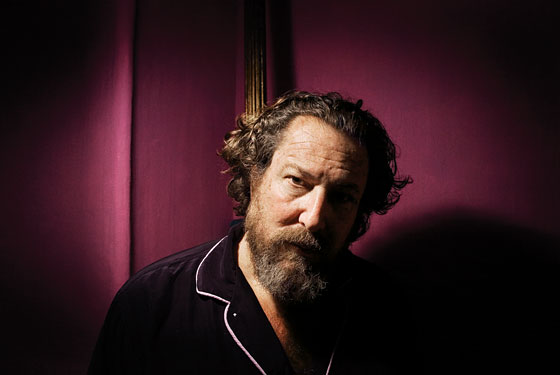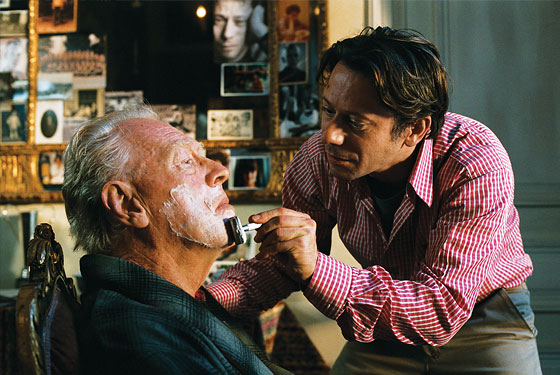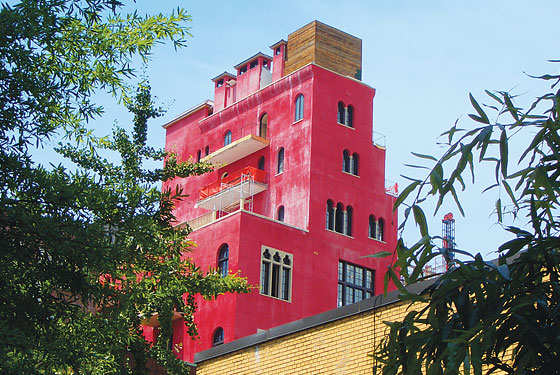
The Palazzo Chupi, on West 11th Street, is like a building in a fairy tale, a soaring, gaudily colored massif with heavy twelve-foot doors and enough balconies to accommodate brigades of Mussolinis. Standing in front of it, looking up, you can imagine how Lemony Snicket’s orphans must have felt as they waited to be ushered into one of Count Olaf’s schemes: Who lives here?
The Palazzo Chupi (the name is on a plaque 25 feet up) is Julian Schnabel’s house, and it’s a characteristically bombastic structure. Built over the former stable in which he has lived since 1987, it’s the size of a seventeen-story building, with vast spaces for Schnabel (his studio could hold a good-sized townhouse, and then some) as well as four other like-minded buyers (Bono was seen touring the building this summer), all sharing a pool.
During the two years of its construction, Schnabel’s palazzo was sheathed in scaffolding and canvas. When it was finally unwrapped, many in the neighborhood were outraged by its scale and, especially, by its color. Andrew Berman, director of the Greenwich Village Society for Historic Preservation, called the color hot pink, which isn’t exactly true—it’s darker than that, and streaked with white, an accident that Schnabel, as has often been his method, decided he liked—but this is the kind of rhetorical excess Julian Schnabel has often inspired in his critics.
Around the same time as the unveiling in June, Schnabel won the Best Director award at Cannes for his third film, The Diving Bell and the Butterfly. It’s a film of elemental power, adapted from a memoir by Jean-Dominique Bauby, the rakish editor of French Elle. At age 43, Bauby had a stroke, leaving him paralyzed, with only the ability to move one eyelid. In a Normandy hospital, he learned to communicate by blinking and by this means managed to write his book, published days before his death in 1996. And by learning to explore his memory and imagination, he discovered a kind of freedom and humanity he’d never known as a prince of the Parisian fast life.
The imaginative promiscuity in Schnabel’s paintings that has so galled critics has here found a context to which it is perfectly suited. There are images of glaciers calving, of insects shot in extreme close-up. There are tubercular children; Napoleon’s niece, in period garb, big-wave surfing; and Bauby in his bathrobe enjoying a feast at a brasserie with his mistress. Other scenes in the movie are shot from the perspective of Bauby’s one functioning eye, and Schnabel uses this limitation to great painterly effect, playing with the frame and focus to re-create Bauby’s claustrophobia. The movie is unpredictable and chaotic—a sprawling, flowing flea market of images—but the effect is one of unity. The fact that it is in French (Schnabel had to improve his restaurant French with intensive lessons before shooting began), with subtitles, hardly gets in its way. Its real language is visual.
There is chaos, also, at the Palazzo Chupi today. Construction is far from complete, but Schnabel plans to spend the night here tonight—his first—so furniture and stacks of Schnabels are being moved in amid the construction debris. Schnabel is on a balcony outside the cavernous hall that will be his bedroom, where two enormous Schnabels—desert scenes with palms and elephants, with scrawled inscriptions about forgetting, in English and French—have been installed around a seven-foot fireplace. Schnabel is surrounded by workmen and assistants, working out how to install a series of columns and a stack of antique Moroccan window grates. He’s in purple pajamas with white piping, and leather slippers. With his curlicuing hair and elfin beard, the effect is both ridiculous and uncanny—Palazzo Chupi’s Willy Wonka. “We’re going to move in some furniture,” he says. “See if I can get my wife to come over.”
Schnabel walks over to the railing and looks out over the city. “I didn’t want to reinvent the wheel,” he says. “There was always neo-Classical architecture in the Village, and this place is not so dissimilar.” He points out a building a few blocks away and notes the similarity in color—which is true, in that both are in the red family.
Below us and slightly to the north is the meatpacking district, where Jack Schnabel, Julian’s father, spent much of his working life. Jack died of prostate cancer in 2004 at the age of 92, and lived with Schnabel for the last year of his life. Schnabel drew heavily on that experience in making The Diving Bell and the Butterfly. In one scene, Bauby’s children play ball on the wide Normandy beach as he sits mute and bundled in a wheelchair, his face a fearsome Cubist mask. Another flashes back on a visit to his own invalid father, in which the younger shaved the older, as the older lectured him on his failed marriage. There’s a disturbing physicality to these images, the forced intimacies that infirmity imposes on people.

Even at 92, Schnabel’s father was terrified of death. “He would grab the rails of his bed and say, ‘I’m slipping, Julie,’” says Schnabel. “I failed him in some way because I couldn’t rob him of that fear.”
But the movie is about a kind of rebirth—it’s an extreme version of a midlife crisis—and making it had a similar effect on Schnabel, who’s 55. “Most artists think about death all the time,” he says. “I did most of my life until I made this movie. It was a kind of self-help device.”
Just then, Schnabel remembers he has to see some workmen on another floor of Palazzo Chupi, so we get into the elevator. We have to squeeze in. There are perhaps ten people onboard: a hefty, dust-covered workman with a drill bit in his hand; a beautiful girl pushing an industrial laundry cart in which are antiques wrapped in moving pads; a squad of Hispanic carpenters. Several languages are being spoken. All eyes are on Schnabel, a circumstance that seems to amplify his intensity. Schnabel is conferring with his trusted foreman, Brian Kelly, whom he’s known since Kelly hung Schnabel’s Castelli show in 1982. The door opens, and a woman hands Schnabel a key. Then the door on the other side opens, and a workman comes with two samples of dark-stained wood and presents them to Schnabel. “We’re trying to reduce the smell.”
“Good idea,” says Schnabel, but decides the new one isn’t good enough. “We can put on some kind of sealant.”
“It’s like directing,” he says as we get off. “When John Ford came onto Dennis Hopper’s set, he said, ‘You’ve just got to keep everyone busy. There shouldn’t be anyone sitting around on a movie set.’”
Schnabel’s three movies, Basquiat, Before Night Falls, and now The Diving Bell and the Butterfly, are all about artists who are in some way oppressed, but then it turns out that their real obstacles, what they have to triumph over in order to fully live, are internal. When one thinks of Schnabel’s career, it’s hard not to imagine that his external obstacle was the critical ire he inspired.
Schnabel’s Mary Boone show in 1979 was the true beginning of the eighties, and in that decade’s theater of excess and envy and Schadenfreude—a long-running show, it still hasn’t closed—he long held center stage. Coming out of the conceptual muddle of the seventies (Is painting dead? And if so, who killed it?), his broken-plate paintings in particular had a shocking freshness—they smashed down a door.
It was when Schnabel himself rushed through the door, too, that all hell broke loose. Schnabel took up a great deal of oxygen in eighties New York, and his arrival coincided with a shift in the fame machinery: winners got more spoils, but every oyster the winners slurped seemed to get written down in a ledger, to be extracted later in blood. With a boastful manner and machismo borrowed from an earlier generation of New York painters, Schnabel did much to stoke these fires. “I’m as close to Picasso as you’re going to get in this fucking life,” he famously said. But where Picasso was a cold father to his creations (and one thinks, in this context, of the Jonathan Richman song: “Pablo Picasso never got called an asshole / Not in New York”), Schnabel loved everything he made, and his extravagant pride tended to produce its opposite. He became a locus of career bitterness, a kind of envy black hole. And besides, whatever his talents, he was too sweet, too approachable, too transparently hungry for adulation, to be able to fully inhabit the myths he wanted to claim for himself. His first act seemed to be ending, even before his savagely reviewed Whitney retrospective in 1987. In some ways, his career looks like that of Norman Mailer, with the differences being that Mailer was able to make ambition a more integral part of his art—and people did not exactly rush out to see Maidstone.
Schnabel says he regrets nothing. Still, one detects a slight sheepishness when he’s talking about where his artistic career has gone. He rattles off a long list of his European exhibitions, and mentions that the eminent art critic Rudi Fuchs, a detractor in the early days, wrote the essay for one of his recent exhibition catalogues.
But in a way, his movies have given new life to his art. “I’ve been having a great time painting,” Schnabel says. “It’s like playing the saxophone. You don’t have to tell anyone what you’re thinking. I’m like a crop rotator. One season is carrots, one season it’s potatoes. There must be part of my brain that is restored.”

Moviemaking allowed Schnabel to be reborn, broke him out of the brutal stalemate he had with his critics. Part of it is that his undeniable talent as a filmmaker has allowed him to transcend the category. And ironically, his youthful braggadocio—his compulsive mythmaking, that song of himself that many found grating—has been shown to feed, in another medium, a huge talent.
Undoubtedly, much of Schnabel is submerged in his films. When Bauby’s ex-wife reappears on the scene to supervise his convalescence, one thinks quickly of Schnabel’s ex, Jacqueline. And Bauby’s enormous needs—to be fed, cared for, loved, laboriously understood—and his inability to give back except in one highly specific way, are a flattering metaphor for many a narcissistic artist, Schnabel included. But where many in the eighties could not look at Schnabel’s paintings and not see Schnabel the man, trying to become the heavyweight champion of art, the films strike almost no one as the same kind of aggressive gesture. “I realize that it’s much harder to understand paintings than movies,” says Schnabel, when asked about the heat he’s taken. “And I’ve lived a very privileged life.”
In any event, Schnabel has put distance between himself and the art world. His friends now are actors: Johnny Depp, Christopher Walken, Sean Penn, Dennis Hopper. “We share certain values,” he says. And Schnabel spends a great deal of time with his family. His children from his first marriage, to Jacqueline (with whom he’s still said to be close), Stella, Lola, and Vito, attended Saint Ann’s and are now Schnabel’s glamorous emissaries in young Manhattan society. He has 13-year-old twins with his second wife, Olatz, who is from San Sebastián, Spain, where Schnabel has a house. (He also has a Stanford White house in Montauk.) She has a fine-linen store on Clarkson Street called, in the family tradition, Olatz. (Schnabel courted her by creating a series of canvases on which he painted her name.)
Soon, Schnabel is zigzagging up, deeper into Palazzo Chupi, bounding over stacks of lumber in his enthusiastic Willy Wonka way. “I have something else to show you that I think you’ll like,” he says.
Unwisely taking notes while climbing a railless staircase, I bump my head on some scaffolding. “Watch your head, watch your head,” says Schnabel belatedly. He points out bathrooms with giant claw-footed tubs and steam showers, the custom balustrades, an enormous rough-hewn granite fireplace suspended from a lift.
Then we step onto a vertiginous terrace on the Palazzo Chupi’s south side. Two workmen are having a beer and a smoke, and in a moment, Schnabel has a beer and a smoke, too.
To the southwest are Richard Meier’s towers, transparent and still partly empty. You can see the river through them. Whether they represent an opposing worldview is an interesting question (where does one hang the art?, for one thing). Certainly, Schnabel thinks so. “When I look at the new inventions that are supposed to be progress, it’s disheartening,” he says.
In reality, however, Schnabel seems not a bit disheartened. Up here, on the ramparts of Palazzo Chupi, his eye is free. He can look down on all of New York: on Meier’s towers, on his father’s old haunts, on the greenish-gray river with its rotting piers. “I know why construction workers do this,” he says as we walk to the rail. “I figured it out when I came up here and I started seeing shit from a place no one else had stood before. That’s why they like to build things.”
Schnabel likes to build things, and he likes what he builds, and he hopes that people like them, but if they don’t, he’s learned to live with that, too.
We move back inside. The elevator is still packed with people, as if no one had ever gotten off. Before I go, he asks me if I have everything I came with. “I always leave something up there,” he says, happily lost in his own creation. “I’m like a rat in a maze.”